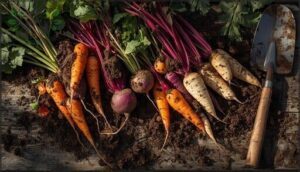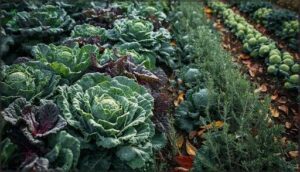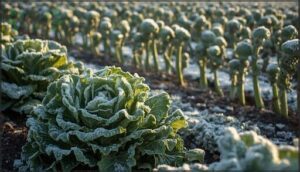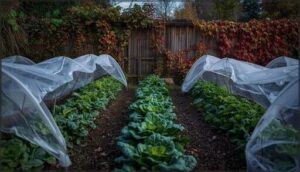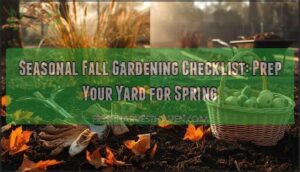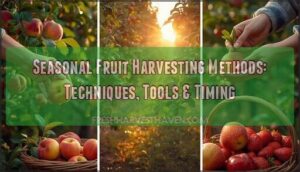This site is supported by our readers. We may earn a commission, at no cost to you, if you purchase through links.

Tending a patch of spinach, carrots, or cabbage this season doesn’t just stretch your harvest; it gives your soil a reset, makes watering simpler, and lets you see the garden’s quieter strengths.
If you time things right, fresh salads and hearty roots could brighten your table long after the first frost.
Table Of Contents
- Key Takeaways
- Fall Planting Basics
- Choosing Fall Vegetables
- Planting Fall Vegetables
- Extending Harvest Season
- Fall Gardening Tips
- Frequently Asked Questions (FAQs)
- What fall vegetables can be planted now?
- When should I start my fall vegetable garden?
- What is the best vegetable to plant in October?
- Is September too late to plant fall vegetables?
- What is the best vegetable to grow in the fall?
- What can I plant right now for fall?
- What are the best vegetables to plant in fall?
- What vegetables go well with celery?
- Can you grow vegetables in the fall?
- Can you plant vegetables in late summer for a fall harvest?
- Conclusion
Key Takeaways
- Cool-season vegetables like kale, spinach, carrots, and broccoli are best planted now for hardy fall and winter harvests.
- Knowing your local frost date is essential, as timing your planting ensures crops mature before freezing temperatures hit.
- Soil health, moisture control, and mulching are crucial for successful fall gardens, helping roots grow strong and keeping plants healthy.
- Fast-growing and cold-hardy crops, paired with succession planting and techniques like row covers, can stretch your harvest long past the first frost.
Fall Planting Basics
Fall gardening isn’t just about throwing seeds in the ground and hoping for the best. You need to understand how cool-season crops work, when to plant them, and what your local climate will allow.
Let’s walk through the essentials that’ll set you up for a successful cold-weather harvest.
Cool Season Crops
Cool season vegetables thrive in temperatures between 50°F and 68°F, making fall an ideal window for planting these hardy crops. Unlike summer vegetables, these cold-weather crops actually taste sweeter after frost exposure, as temperatures below 32°F convert starches into sugars. You’ll enjoy better pest management too, since fewer insects remain active as temperatures drop.
Cool-season vegetables planted in fall taste even sweeter after frost and thrive as pests and heat fade away
Here’s why you should prioritize cool-season crops:
- Soil health improves through crop rotation with different seasonal plantings
- Variety selection matters—choose regionally adapted types for best results
- Watering needs decrease naturally as cooler weather reduces evaporation
- Fall harvest crops like kale and broccoli withstand temperatures down to 20°F
Plant your fall vegetables now to get the most out of flavor and nutrition throughout winter. Consider planting now for a winter harvest.
Planting Time Calculation
Getting your planting window right means working backward from your first frost date. You’ll calculate planting dates by subtracting the days to maturity from that frost date, then adding 14 days—that’s the fall factor explained. This buffer accounts for shorter days and cooler temperatures that slow growth by 10-20% compared to spring.
Soil temperature matters just as much as air temperature. Check that your soil reaches at least 60°F for most cool-season crops before planting. A simple soil thermometer takes the guesswork out of calculating planting dates. Regional variations can shift your schedule by two to three weeks, even within the same hardiness zone.
For a crop needing 60 maturity days with an October 10 first frost date, you’d plant by late July—giving enough time for harvest before temperatures drop. Consider using online date calculators to simplify this process.
First Frost Dates
Your first frost date determines everything about fall planting success. Check online frost date calculators using your zip code—they’ll show when temperatures usually drop to 32°F in your area. While USDA Zone timing gives you a starting point, microclimate variations matter more than you’d expect. Urban heat islands can delay frost by 7–10 days compared to rural areas, and historical frost shifts show dates arriving 11 days later nationwide since the 1970s.
Consider these frost date trends affecting your planting dates:
- Zone 5 sees first frost between October 13–21, while Zones 7–8 wait until late October through November
- Cities now experience frost an average of 11 days later than in the early 1970s
- Reno, Nevada’s first frost occurs 41 days later than historical averages
- Coastal gardens enjoy 5–15 extra frost-free days compared to inland locations
- Cold air drainage in rural valleys triggers earlier frost than nearby hilltops
These patterns help you schedule cold weather fall vegetables like kale and carrots to mature before damaging temperatures arrive.
Benefits of Fall Gardening
Once you know when frost arrives, you can tap into fall gardening’s real advantages. Pest control improves dramatically—cooler autumn temperatures cut insect pest populations by up to 70% compared to summer’s bug battles. You’ll spend less time fighting aphids and more time harvesting.
Soil health gets a boost too. Incorporating organic matter during fall increases soil carbon levels by 20%, setting up stronger fertility for next season. Water efficiency jumps as plants use 40% less water than peak summer demands, and predictable rainfall does much of the work for you.
Here’s what makes autumn harvest truly rewarding:
- Nutritional advantages: Fall vegetables like kale and carrots contain 20–30% more vitamin C than summer-grown crops
- Ecological benefits: Cover crops reduce winter soil erosion by 75% while supporting pollinators
- Extended growing season: Cool weather crops thrive in conditions that would wilt summer varieties
These fall gardening tips translate into sweeter flavors, healthier soil, and fresh vegetables when grocery store options dwindle.
Choosing Fall Vegetables
Not all fall crops are created equal—some thrive in cold weather, while others need a head start before frost arrives. Choosing the right vegetables means matching your local climate with plants that can handle shorter days and cooler soil.
Let’s look at four types of fall crops that deliver reliable harvests when autumn sets in.
Root Vegetables
Root vegetables are the workhorses of fall gardening, delivering superior nutrition and sweetness through a process called frost sweetening. When you plant carrots, beets, turnips, and parsnips 10-12 weeks before your first frost, these crops convert stored starches into natural sugars as temperatures drop. This means sweeter, more flavorful harvests than you’d get in summer. Carrots pack around 8.2 mg of beta-carotene per 100 grams, while beets deliver 325 mg of potassium and nearly 3 grams of fiber.
For success with planting fall vegetables, maintain a soil pH between 6.0-7.0 and provide consistent moisture—about 1 inch weekly. Their nutrient needs are moderate; excessive nitrogen actually delays root development.
Storage methods are straightforward: keep unwashed roots at 32-38°F with high humidity, and they’ll last four months. That’s fall vegetables done right.
Leafy Greens and Brassicas
Leafy greens and brassicas are cold-weather crops that transform fall gardens into nutritional powerhouses. Kale and collards withstand temperatures down to 15°F, while Brussels sprouts and broccoli thrive between 65-75°F with fewer pest problems than summer plantings.
These cool-season vegetables deliver impressive nutritional benefits—one cup of broccoli provides more vitamin C than an orange, and fall varieties develop sweeter flavors after frost exposure.
For companion planting success, pair brassicas with herbs that deter cabbage moths while maintaining cold hardiness through proper spacing and soil fertility.
Fast Growing Crops
When fall planting windows arrive, some fall vegetables race from seed to table faster than you’d expect. Radishes lead the pack, maturing in just 21 to 30 days—certain varieties like ‘Cherry Belle’ deliver crisp roots within three weeks. These quick crop rotation champions thrive in 50-70°F temperatures, perfect for succession strategies throughout autumn.
Your fastest options include:
- Radishes – 21-30 days, with succession planting every 7-10 days
- Mustard greens – 20-21 days for baby leaf harvest, 45 for full-size
- Spinach – 28-39 days for baby leaves, under 50 for maturity
- Arugula – 21-50 days depending on variety
- Lettuce – 30-50 days, continuous cutting possible
Germination times decrease as soil temperatures remain between 45-65°F, and these fast-growing vegetables actually produce sweeter flavors than spring plantings.
Cold Hardy Crops
Think of kale and collards as your garden’s winter warriors—they don’t just survive frost down to 10°F, they actually taste sweeter after exposure. These frost-resistant varieties excel in zones 3-9, where cold acclimation triggers sugar accumulation.
Brussels sprouts and cabbage remain harvestable through hard freezes, while parsnips and leeks persist near 0°F, making them ideal for overwintering techniques and continuous harvest.
Microclimate effects like row covers can push zone adaptability even further with these cold-hardy vegetables.
Planting Fall Vegetables
Once you’ve chosen your fall vegetables, success depends on getting them in the ground the right way. Proper soil prep, correct planting depth, and smart watering practices make the difference between a thriving fall garden and a disappointing one.
Here’s what you need to know to give your cool-season crops the best start possible.
Soil Preparation
Proper soil preparation sets the stage for a thriving fall harvest. You’re basically building a strong foundation—one that promotes root development, nutrient uptake, and moisture retention through cooler months.
Start by testing your soil pH and adjusting it to 6.0-7.0, since deficiencies in essential nutrients occur below this range. Next, incorporate organic matter to boost soil health:
- Mix in 2-3 inches of compost or aged manure to 8-12 inches deep for improved soil structure and nutrients
- Test soil temperature to confirm it’s at least 50°F before planting cool-season crops
- Remove rocks, weeds, and debris to reduce disease risk and competition
- Check soil texture by ensuring it’s dark, crumbly, and moist after amendments
- Water thoroughly after tilling to distribute nutrients and settle the soil structure
Proper moisture management and soil conditions directly impact your fall vegetables’ success.
Planting Depth and Spacing
Getting planting depth and seeds spacing right isn’t rocket science, but precision matters for seed germination and root development. Tiny lettuce seeds need just 0.125 inches of soil, while carrots go 0.25 inches deep and beets settle at 0.5 inches.
Plant spacing prevents soil compaction and ensures proper air circulation—space carrots 2–3 inches apart, radishes at 1 inch, and kale 8–16 inches depending on variety.
Row arrangement also affects plant density: most fall crops thrive with 18–36 inch rows, giving roots room to expand without competing for nutrients.
Watering and Mulching
Once you’ve settled depth and spacing, watering techniques and mulching become your moisture retention allies. Fall vegetables need about 1 inch of water weekly—but here’s where seasonal management matters: cooler temperatures mean you’ll water less often than summer, shifting to every 3–7 days depending on the crop.
Smart watering frequency fosters deep roots while organic mulches work overtime protecting soil conditions:
- Water early morning before 10 a.m. to cut evaporation losses by 25% and boost soil moisture absorption
- Layer 2–3 inches of straw or shredded leaves around plants to suppress weeds by 50–85% and retain 30% more water
- Check moisture 6 inches deep using your finger or a soil probe—roots need saturation at planting depth without waterlogging
- Apply mulch right after watering to trap residual moisture and reduce surface drying by roughly 40%
This combination of mulch efficiency and adjusted watering keeps your fall garden thriving through temperature swings.
Extending Harvest Season
Once your fall vegetables are in the ground, you can stretch the productive season well beyond what nature alone would allow. A few simple techniques protect plants from cold snaps and keep harvests coming for weeks or even months longer.
Let’s look at four proven methods to extend your fall garden’s productivity.
Succession Planting
Staggering your plantings unlocks continuous harvests instead of one overwhelming glut. With succession planting, you’ll sow the same fall vegetables every 10-14 days—these planting intervals keep lettuce, radishes, and spinach flowing to your table for weeks.
Start in mid-summer and repeat through early fall to get the most from garden yields. This planting schedule for cool-season crops can boost your total output by up to 35% while improving soil fertility between cycles.
Smart crop selection matters: choose fast-maturing varieties and calculate backward from your frost date. The economic impact adds up—you’ll harvest only what you need, reducing waste and potentially saving hundreds on groceries annually.
Row Covers and Cold Frames
Beyond succession planting, row covers and cold frames give you powerful thermal regulation to protect fall crops from frost. Row covers boost temperatures by 5–15°F, with heavyweight options defending plants down to 25°F—that’s serious frost protection for cold weather gardening. Material efficiency varies: lighter fabrics allow 85–95% light penetration, while heavier designs sacrifice some sunlight for better season extension.
Cold frames extend your growing zone warmer by up to one-and-a-half hardiness levels through passive solar energy, raising temperatures 7–12°F without electricity. The yield impact is real—expect up to 25% higher harvests with improved crop quality. Design variations like south-facing frames and straw bale insulation heighten energy benefits while cutting costs compared to heated greenhouses.
Storing and Preserving
Once you’ve tucked your crops under a row cover or in a cold frame, the real magic is how you make your harvest last. Curing techniques—for example, allowing squash skins time to harden or laying potatoes in a dark spot—often mean the difference between quick spoilage and winter storage vegetables that actually last. Moist root cellars are a classic for storing carrots and beets; just keep them damp and cool. Looking for a plan? Try:
- Cure squash, onions, and potatoes before storage.
- Store carrots and beets unwashed in damp sand at 32–40°F.
- Blanch and freeze greens to lock in flavor and nutritional retention.
- Hang-dry herbs or pickle surplus roots for flavorful winter meals.
Harvesting vegetables with storage in mind gives your hard work a lasting payoff.
Choosing Right Varieties
Wondering how to keep your fall vegetables thriving right up to winter? Choose cold-hardy cultivars and frost-tolerant vegetable varieties that are bred for disease resistance and regional adaptation. Match maturity dates to your first frost, and savor cool-season vegetables whose flavor profiles—like cold-sweetened kale—shine after a nip of cold.
| Quality | Example Variety |
|---|---|
| Cold-hardiness | ‘Winterbor’ Kale |
| Fast maturity | ‘French Breakfast’ Radish |
| Disease resistance | ‘Bolero’ Carrot |
| Choice flavor | ‘Red Russian’ Kale |
Fall Gardening Tips
Every fall garden comes with its own set of challenges and choices, shaped by where you live and the weather at hand. Before you get started, it’s smart to think through what works best for your zone and climate.
Here are some tips to help guide you through those decisions.
Geographic and Climate Considerations
Think your garden is just like your neighbor’s? Not so fast—frost date variability, microclimate effects, and elevation all shape your actual planting window. One zone’s mild autumn can mean another’s early deep freeze. The USDA Plant Hardiness Map helps, but don’t ignore local quirks or recent climate change shifts.
Here’s what matters:
- Know your local frost dates.
- Factor in microclimates (lakes, hills, cities).
- Watch temperature requirements for each crop.
- Adjust for precipitation impact each fall.
Zone Based Planting Schedules
For fall planting, your zone is your compass. Following a zone-based planting schedule takes away all the guesswork, letting you match crops to your unique climate and catch that narrow planting window by zone. For instance, Zone-Specific Varieties thrive when sown at just the right moment—Zone 3-4 gardeners get a jumpstart mid-summer, while those in Zones 7-8 have more wiggle room into September.
Mind your microclimate impacts, and use the USDA Plant Hardiness Map to fine-tune your strategies:
- Track regional variations closely
- Lean into frost tolerance
- Adjust for best timing
Hardiness Zones and Frost Dates
Chilly nights are nature’s reminder: your garden’s fate rests on understanding Plant Hardiness Zones and frost dates. Your zone tells you the average winter low temperature, shaping your choices for cold-hardy, frost-tolerant vegetables. But watch for microclimate effects—urban heat, windbreaks, or a snowy blanket can create regional variations and boost zone limitations.
Here’s how to stay ahead:
- Pinpoint your Plant Hardiness Zone.
- Calculate your first expected frost date.
- Factor in microclimate quirks.
- Prepare frost protection for sensitive crops.
Common Mistakes to Avoid
Planting fall vegetables? Even seasoned gardeners hit a snag. Timing errors—like sowing seeds too late—often leave you battling frost damage or stunted crops. Skimping on soil prep is another pitfall; healthy roots demand rich, airy ground, not compacted clay.
Neglecting pests or disease control opens the door to hidden trouble—slugs, cabbage worms, and lingering plant debris threaten young greens. Improper watering, whether too much or too little, stresses plants and encourages rot. Over-pruning strips away essential insulation or bird food.
Avoiding these common gardening mistakes and paying close attention to soil conditions means a more bountiful and resilient late-season harvest every year.
Frequently Asked Questions (FAQs)
What fall vegetables can be planted now?
Cool-season varieties like spinach, lettuce, kale, carrots, and broccoli flourish when sown now. Each brings great market value and thrives in mild soil temperatures, making these picks practical for your fall garden’s tight planting windows and quick days to maturity.
When should I start my fall vegetable garden?
Let’s “leaf” nothing to chance—start your fall vegetable garden 6–8 weeks ahead of your first frost date.
Factor in maturity length, zone hardiness, and soil temperature to fine-tune your planting window for resilient, tasty cold-weather harvests.
What is the best vegetable to plant in October?
October planting is a sweet spot for leafy greens like spinach and lettuce. Both thrive in cool weather, tolerate light frost, and reach maturity quickly—making them ideal for fresh harvests even as soil temperature drops.
Is September too late to plant fall vegetables?
September planting isn’t too late for fall vegetables. With a firm eye on your planting window, crop maturity, and first frost date, you can start quick growers like lettuce, spinach, or radishes and still harvest before winter’s chill.
What is the best vegetable to grow in the fall?
Kale stands out as the top choice for fall vegetables. It thrives in cool weather, meets diverse nutrient needs, resists pests, grows sweeter after frost, and offers a superb flavor profile, long storage life, and endless culinary uses.
What can I plant right now for fall?
If summer’s veggies ruled the garden like stubborn monarchs, late-season planting laughs in the face of the chill. Quick-grow crops like spinach, lettuce, and frost-tolerant veggies make succession strategies and immediate harvests for fall crops a cinch.
What are the best vegetables to plant in fall?
If you’re aiming for a resilient fall harvest, focus on cool-season varieties like spinach, lettuce, carrots, broccoli, and kale. These frost-tolerant veggies thrive as soil temperature drops, making them cornerstones of any fall vegetables gardening plan.
What vegetables go well with celery?
Think of your fall garden like a symphony—celery’s crisp note pairs beautifully with carrots, onions, and bell peppers for rich flavor profiles.
For nutritional synergy in cool-season crops, try mixing celery into fall salad ingredients and stews.
Can you grow vegetables in the fall?
Absolutely, you can grow vegetables in the fall. With the right planting guide, cool-season crops like carrots, lettuce, and kale actually prefer cooler weather, boosting fall vegetable viability, seasonal crop productivity, and gardening success across diverse regional climates.
Can you plant vegetables in late summer for a fall harvest?
Late-Summer Planting is a smart way to get a jump on cool-season crops. If you start fall vegetables planting six to eight weeks before frost, these fall crops—like kale or spinach—will thrive and provide a timely fall harvest.
Conclusion
Investigate the truth of a theory: autumn’s chill doesn’t end your gardening—sometimes, it refines it. When you choose the best fall vegetables to plant now, you’re not simply extending the season; you’re inviting resilience and flavor into your kitchen.
Each time you plant a carrot or kale seed, you claim a small victory against the frost. These cool-weather days reward the mindful grower, turning quiet effort into heartening harvests when most gardens have already gone silent.
- https://rootsandrefuge.com/what-to-plant-in-july/
- https://www.almanac.com/how-plant-fall-vegetable-garden
- https://warren.cce.cornell.edu/gardening-landscape/warren-county-master-gardener-articles/fall-planting-for-the-vegetable-garden
- https://www.farmersalmanac.com/calendar/gardening
- https://www.youtube.com/watch?v=BC3iU1f-Va8

